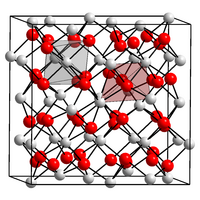Californium (III) oxide
| Crystal structure | |||||||
|---|---|---|---|---|---|---|---|

|
|||||||
| __ Cf 3+ __ O 2− | |||||||
| Space group |
Ia 3 (No. 206) |
||||||
| Lattice parameters |
a = 1084 pm |
||||||
| General | |||||||
| Surname | Californium (III) oxide | ||||||
| other names |
|
||||||
| Ratio formula | Cf 2 O 3 | ||||||
| Brief description |
yellow-green solid |
||||||
| External identifiers / databases | |||||||
|
|||||||
| properties | |||||||
| Molar mass | 550.157 g mol −1 | ||||||
| Physical state |
firmly |
||||||
| Melting point |
1750 ° C |
||||||
| Hazard and safety information | |||||||
 Radioactive |
|||||||
|
|||||||
| Thermodynamic properties | |||||||
| ΔH f 0 |
−1652.6 ± 10.3 kJ mol −1 |
||||||
| As far as possible and customary, SI units are used. Unless otherwise noted, the data given apply to standard conditions . | |||||||
Californium (III) oxide is an oxide of the element californium . It has the molecular formula Cf 2 O 3 . Since all isotopes of californium are only artificially produced, californium (III) oxide does not occur naturally.
properties
Californium (III) oxide is a yellow-green solid with a melting point of 1750 ° C and forms two modifications. The body-centered cubic modification forms a crystal lattice with a = 1083.9 ± 0.4 pm . The transition temperature between the body-centered cubic and the monoclinic Cf 2 O 3 is about 1400 ° C.
The enthalpy of formation at 25 ° C was determined to be −1652.6 ± 10.3 kJ mol −1 .
use
It is mainly used in the manufacture of 252 Cf neutron sources. For this purpose, 252 Cf (III) is first precipitated as californium oxalate (Cf 2 (C 2 O 4 ) 3 ), dried and then calcined to give a trivalent oxide.
safety instructions
Classifications according to the CLP regulation are not available because they only include chemical hazard and play a completely subordinate role compared to the hazards based on radioactivity . The latter also only applies if the amount of substance involved is relevant.
Individual evidence
- ^ A b c A. F. Holleman , E. Wiberg , N. Wiberg : Textbook of Inorganic Chemistry . 102nd edition. Walter de Gruyter, Berlin 2007, ISBN 978-3-11-017770-1 , p. 1972.
- ↑ The hazards emanating from radioactivity do not belong to the properties to be classified according to the GHS labeling. With regard to other hazards, this substance has either not yet been classified or a reliable and citable source has not yet been found.
- ↑ a b Lester R. Morss, J. Fuger, J. Goffart, N. Edelstein, GV Shalimoff: Enthalpy of Formation and Magnetic Susceptibility of Californium Sesquioxide, Cf 2 O 3 , in: Journal of the Less Common Metals , 1987 , 127 , Pp. 251-257 ( doi: 10.1016 / 0022-5088 (87) 90385-7 ).
- ^ JL Green, BB Cunningham: Crystallography of the Compounds of Californium. I. Crystal Structure and Lattice Parameters of Californium Sesquioxide and Californium Trichloride , in: Inorg. Nucl. Chem. Lett. , 1967 , 3 (9), pp. 343-349 ( doi: 10.1016 / 0020-1650 (67) 80040-0 ).
- ↑ JC Copeland, BB Cunningham: Crystallography of the Compounds of Californium. II. Crystal Structure and Lattice Parameters of Californium Oxychloride and Californium Sesquioxide , in: J. Inorg. Nucl. Chem. , 1969 , 31 (3), pp. 733-740 ( doi: 10.1016 / 0022-1902 (69) 80020-5 ).
- ↑ RD Baybarz, RG Haire, JA Fahey: On the Californium Oxide System , in: J. Inorg. Nucl. Chem. , 1972 , 34 (2), pp. 557-565 ( doi: 10.1016 / 0022-1902 (72) 80435-4 ).
- ↑ United States Patent 3627691: A Method of Preparing a Californium-252 Neutron Source .
literature
- Richard G. Haire: Californium , in: Lester R. Morss, Norman M. Edelstein, Jean Fuger (Eds.): The Chemistry of the Actinide and Transactinide Elements , Springer, Dordrecht 2006; ISBN 1-4020-3555-1 , pp. 1499-1576 ( doi: 10.1007 / 1-4020-3598-5_11 ).